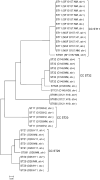Shiga toxin-mediated hemolytic uremic syndrome: time to change the diagnostic paradigm?
- PMID: 17925872
- PMCID: PMC1995754
- DOI: 10.1371/journal.pone.0001024
Shiga toxin-mediated hemolytic uremic syndrome: time to change the diagnostic paradigm?
Abstract
Background: Hemolytic uremic syndrome (HUS) is caused by enterohemorrhagic Escherichia coli (EHEC) which possess genes encoding Shiga toxin (stx), the major virulence factor, and adhesin intimin (eae). However, the frequency of stx-negative/eae-positive E. coli in stools of HUS patients and the clinical significance of such strains are unknown.
Methodology/principal findings: Between 1996 and 2006, we sought stx-negative/eae-positive E. coli in stools of HUS patients using colony blot hybridization with the eae probe and compared the isolates to EHEC causing HUS. stx-negative/eae-positive E. coli were isolated as the only pathogens from stools of 43 (5.5%) of 787 HUS patients; additional 440 (55.9%) patients excreted EHEC. The majority (90.7%) of the stx-negative/eae-positive isolates belonged to serotypes O26:H11/NM (nonmotile), O103:H2/NM, O145:H28/NM, and O157:H7/NM, which were also the most frequent serotypes identified among EHEC. The stx-negative isolates shared non-stx virulence and fitness genes with EHEC of the corresponding serotypes and clustered with them into the same clonal complexes in multilocus sequence typing, demonstrating their close relatedness to EHEC.
Conclusions/significance: At the time of microbiological analysis, approximately 5% of HUS patients shed no longer the causative EHEC, but do excrete stx-negative derivatives of EHEC that lost stx during infection. In such patients, the EHEC etiology of HUS is missed using current methods detecting solely stx or Shiga toxin; this can hamper epidemiological investigations and lead to inappropriate clinical management. While maintaining the paradigm that HUS is triggered by Shiga toxin, our data demonstrate the necessity of considering genetic changes of the pathogen during infection to adapt appropriately diagnostic strategies.
Conflict of interest statement
Figures

References
-
- Tarr PI, Gordon CA, Chandler WL. Shiga toxin-producing Escherichia coli and the haemolytic uraemic syndrome. Lancet. 2005;365:1073–1086. - PubMed
-
- Karch H, Tarr PI, Bielaszewska M. Enterohaemorrhagic Escherichia coli in human medicine. Int J Med Microbiol. 2005;295:405–418. - PubMed
-
- Siegler RL. Postdiarrheal Shiga toxin-mediated hemolytic uremic syndrome. JAMA. 2003;290:1379–1381. - PubMed
-
- Gerber A, Karch H, Allerberger F, Verweyen HM, Zimmerhackl LB. Clinical course and the role of Shiga toxin-producing Escherichia coli infection in the hemolytic-uremic syndrome in pediatric patients, 1997–2000, in Germany and Austria: a prospective study. J Infect Dis. 2002;186:493–500. - PubMed
Publication types
MeSH terms
Substances
LinkOut - more resources
Full Text Sources
Other Literature Sources
Medical

